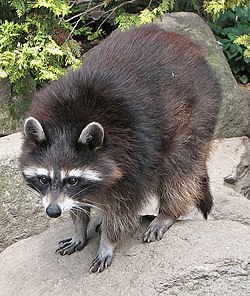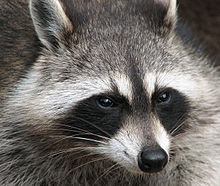| Revision as of 14:05, 1 November 2006 view sourceAntiVandalBot (talk | contribs)258,750 editsm BOT - rv 207.156.196.242 (talk) to last version by Durova← Previous edit | Revision as of 16:58, 16 November 2006 view source 168.8.117.204 (talk)No edit summaryNext edit → | ||
| Line 19: | Line 19: | ||
| }} | }} | ||
| The '''Common Raccoon''' (''Procyon lotor''), also known as the '''Northern Raccoon''', '''Racoon''', or '''Coon''', is a widespread, medium-sized, ] ] of ]. Since the 20<sup>th</sup> Century, raccoons have also become widespread on the ] mainland and in the ], after escaping from ].{{fact}} Raccoons usually live together in small, loose, groups. Their original habitats are ] or ] ]s, but due to their adaptability are often found in ] areas. | The '''Common Raccoon''' (''Procyon lotor''), also known as the '''Northern Raccoon''',looks like shit '''Racoon''', or '''Coon''', is a widespread, medium-sized, ] ] of ]. Since the 20<sup>th</sup> Century, raccoons have also become widespread on the ] mainland and in the ], after escaping from ].{{fact}} Raccoons usually live together in small, loose, groups. Their original habitats are ] or ] ]s, but due to their adaptability are often found in ] areas. | ||
| At one time, raccoons were aggressively trapped for their fur. Populations suffered greatly but have recovered. In popular culture, American frontiersmen such as ] and ] were often portrayed wearing coonskin hats. It is unlikely, however, that either of them actually wore coonskin caps. <!--Samuel I. Zeveloff, in ''Raccoons: A Natural History'', argues that it's unlikely that Crockett actually wore a coonskin hat. Boone hated such hats and did not wear them--see the article on Daniel Boone. --> | At one time, raccoons were aggressively trapped for their fur. Populations suffered greatly but have recovered. In popular culture, American frontiersmen such as ] and ] were often portrayed wearing coonskin hats. It is unlikely, however, that either of them actually wore coonskin caps. <!--Samuel I. Zeveloff, in ''Raccoons: A Natural History'', argues that it's unlikely that Crockett actually wore a coonskin hat. Boone hated such hats and did not wear them--see the article on Daniel Boone. --> | ||
Revision as of 16:58, 16 November 2006
| Common Raccoon (or Racoon) | |
|---|---|

| |
| Conservation status | |
 Least Concern | |
| Scientific classification | |
| Kingdom: | Animalia |
| Phylum: | Chordata |
| Class: | Mammalia |
| Order: | Carnivora |
| Family: | Procyonidae |
| Genus: | Procyon |
| Species: | P. lotor |
| Binomial name | |
| Procyon lotor (Linnaeus, 1758) | |
| File:Waschbärpopulation.png | |
| Common Raccoon range (in red) | |
The Common Raccoon (Procyon lotor), also known as the Northern Raccoon,looks like shit Racoon, or Coon, is a widespread, medium-sized, omnivorous mammal of North America. Since the 20 Century, raccoons have also become widespread on the European mainland and in the Caucasus, after escaping from fur farms. Raccoons usually live together in small, loose, groups. Their original habitats are Mixed or Deciduous forests, but due to their adaptability are often found in urban areas. At one time, raccoons were aggressively trapped for their fur. Populations suffered greatly but have recovered. In popular culture, American frontiersmen such as Daniel Boone and Davy Crockett were often portrayed wearing coonskin hats. It is unlikely, however, that either of them actually wore coonskin caps.
Appearance

Adult weights vary with habitat but an average is about 5.5 to 9.5 kg (12 to 21 pounds), the largest recorded being over 28 kg (61 pounds) . They have black facial colorings around the eyes, and have a bushy tail with light and dark alternating rings. The coat is a mixture of gray, brown, and black fur. On rare occasions, raccoons may be albino. The characteristic eye colorings make the animal look like it is wearing a "bandit's mask," which has enhanced the animal's reputation for mischief, vandalism, and thievery.
A raccoon's mouth consists of 40 teeth, which are adapted to an omnivore life-style. The chewing surface is not as wide as for herbivore's, but the teeth are not as sharp and pointed as that of a carnivore.
Mating
Mating usually occurs in January or February and a litter of four or five young are born in April or May (varies by climate). Raccoons usually live in hollow trees, ground burrows, or caves. They like to travel along streams or rivers in search of food. However there are raccoons that live in the forest not near any stream. Males have no part in raising the young. By late summer, the litter will be weaned and will begin to fend for themselves. In severe winter climates, raccoons may become dormant but do not hibernate.
Range
Raccoons are common throughout North America from southern Canada to Panama. Raccoons are one of the largest animals to have adapted well to human development. Suburban areas, and many large cities, have significant raccoon populations. Raccoons are skilled foragers who can thrive on garbage and pet food. They have been known to take up residence in attics and garages, and even to enter houses through "pet doors" in search of food. When confronted by humans or household animals, raccoons may be aggressive. Raccoons that live in cities, however, and thus in proximity to humans, are usually a little less so. Urban raccoons tend to lose their fear of humans over time (especially in wooded areas of urban centres) but this seems to develop in them more of a sense of "if you don't bother me, I won't bother you." A good example of this can be seen if a glass windowpane ever separates human and city-dwelling raccoon. As often as not, the raccoon's response will be indifference or even curiosity, even while under direct observation.

In 1934 German Luftwaffe general Hermann Goering decided to release a pair of raccoons into the German wilderness to "enrich the Reich's fauna." The raccoons have since been extremely successful due to the lack of natural enemies. Others are believed to have escaped from fur farms during Allied bombing in World War II.
The German newsmagazine Der Spiegel reported in 2002 that the raccoon had established itself in a small area of north-central France and in a considerable area of central Germany, where it had become a neighborhood pest to some and a beloved pet to others.
While racoons held in captivity can live up to 20 years old up, they seldom live longer than 12 years in the wild, with most only living a few years. It is not unusual that only half of all males born survive the first year, with a life expectancy of only about 1.3 to 3.1 years. Illnesses, accidents, and the death of the mother are the most common causes of death for young raccoons. For adult raccoons, traffic incidents and hunting account for more than 75% of deaths. In the 1980s in the United States, nearly five million raccoons were shot every year.
References
External links
- Raccoon Tracks information, accounts, and images
- range of raccoon populations, Missouri Botanical Garden
- Feature Creatures: Raccoon University of Alberta Museum of Zoology
- Remo Raccoon's Home Page
- Nazi Raccoons On The March In Europe article about history of raccoon introduction in Germany
Template:Link FA Template:Link FA
Categories: